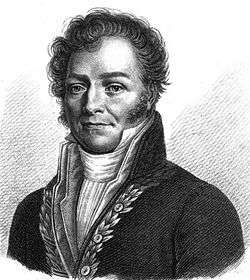Louis Jacques Thénard
| Louis Jacques Thénard | |
|---|---|
|
Louis Jacques Thénard | |
| Born |
4 May 1777 La Louptière, Champagne (present-day Aube) |
| Died |
21 June 1857 (aged 80) Paris |
| Nationality | French |
| Fields | chemistry |
| Doctoral advisor | Louis Nicolas Vauquelin |
Louis Jacques Thénard (4 May 1777 – 21 June 1857), was a French chemist.
Life
His father, a poor peasant, managed to have him educated at the academy of Sens, and sent him at the age of sixteen to study pharmacy in Paris. There he attended the lectures of Antoine François Fourcroy and Louis Nicolas Vauquelin. He was allowed into Vauquelin's laboratory even though he was unable to pay the monthly fee of 20 francs, due to the requests of Vauquelin's sisters.[1] and succeeded in gaining admission, in a humble capacity, to the latter's laboratory. But his progress was so rapid that in two or three years he was able to take his master's place at the lecture-table, and Fourcroy and Vauquelin were so satisfied with his performance that they procured for him a school appointment in 1797 as teacher of chemistry, and in 1798 one as répétiteur at the École Polytechnique.[2]
Career
In 1804 Vauquelin resigned his professorship at the Collège de France and successfully used his influence to obtain the appointment for Thénard, who six years later, after Fourcroy's death, was further elected to the chairs of chemistry at the École Polytechnique and the Faculté des Sciences. He also succeeded Fourcroy as member of the Academy. In 1821, he was elected a foreign member of the Royal Swedish Academy of Sciences. In 1825 he received the title of baron from Charles X, and in 1832 Louis Philippe made him a peer of France. From 1827 to 1830 he represented the département of Yonne in the chamber of deputies, and as vice-president of the conseil superieur de l'instruction publique, he exercised a great influence on scientific education in France. He died in Paris on 21 June 1857. A statue was erected to his memory at Sens in 1861, and in 1865 the name of his native village was changed to La Louptière-Thénard.[2]
Above all things Thénard was a teacher; as he himself said, the professor, the assistants, the laboratory — everything must be sacrificed to the students. Like most great teachers he published a textbook, and his Traité de chimie élémentaire, théorique et pratique (4 vols., Paris, 1813–16), which served as a standard for a quarter of a century, perhaps did even more for the advance of chemistry than his numerous original discoveries.[2]
Research
Soon after his appointment as répétiteur at the École Polytechnique he began a lifelong friendship with Joseph Louis Gay-Lussac, and the two carried out many research projects together. Careful analysis led him to dispute some of Claude Louis Berthollet's theoretical views regarding the composition of the metallic oxides, and he also showed Berthollet's "zoonic acid" to be impure acetic acid (1802). In response, Berthollet invited him to become a member of the Society of Arcueil.[2]
His first original paper (1799) was on the compounds of arsenic and antimony with oxygen and sulphur. In 1807, he began important research into ethers. His researches on sebacic acid (1802) and on bile (1807) deserve mention as well, as does his discovery of hydrogen peroxide (1818).[3] In 1799 he developed the pigment known as Thénard's blue in response to a request by Jean-Antoine-Claude Chaptal for a cheap colouring matter.[2]
His name is one of the 72 names inscribed on the Eiffel Tower.
References
- ↑
 Herbermann, Charles, ed. (1913). "Baron Louis-Jacques Thénard". Catholic Encyclopedia. New York: Robert Appleton Company.
Herbermann, Charles, ed. (1913). "Baron Louis-Jacques Thénard". Catholic Encyclopedia. New York: Robert Appleton Company. - 1 2 3 4 5 Chisholm 1911.
- ↑ L. J. Thénard (1818) “Observations sur des nouvelles combinaisons entre l’oxigène et divers acides,” Annales de chimie et de physique, 2nd series, vol. 8, pages 306-312; see especially page 308.
- Attribution
![]() This article incorporates text from a publication now in the public domain: Chisholm, Hugh, ed. (1911). "Thénard, Louis Jacques". Encyclopædia Britannica. 26 (11th ed.). Cambridge University Press.
This article incorporates text from a publication now in the public domain: Chisholm, Hugh, ed. (1911). "Thénard, Louis Jacques". Encyclopædia Britannica. 26 (11th ed.). Cambridge University Press.
